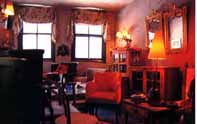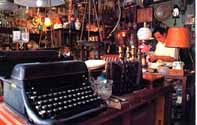|
Çukurcuma
is one of İstanbuls oldest districts, and one of the most
colorful parts of Beyoğlu. When I say one of the oldest districts,
I do not mean just a couple of centuries. Çukurcuma dates back no
less than five and a half centuries, in other words it is
contemporary with the Turkish conquest of the city.
The
streets of Çukurcuma are today lined by junk shops and antique
shops, so it is an area which best reflects the old atmosphere of
Beyoğlu.
To
get to Çukurcuma walk down the hill from Taksim to Tophane.
Although Çukurcuma is in fact the name of a short street, the whole
area has come to be known after it. The street in turn takes its
name from Çukurcuma Mosque, which was built by Mimar
Sinan in the 1540s at the
request of Şeyhulislam Muhiddin Mehmed Efendi. The
wear of centuries and several fires have destroyed most of the 16th
century structure, only the base of the minaret and a small part of
the interior walls remaining to link it with the original mosque
built by Mimar Sinan. No inscription referring to him as architect
remains either. After the fire which swept through the district in
1823 the mosque was largely rebuilt, and it was extensively repaired
in 1968. Today this well cared for small wooden mosque is still in
use.
The
fountain opposite the mosque was founded by Ömer Ağa, one of the
treasurers of Mahmud I (1730-1754), probably soon after the
construction of the Sultan Mahmud Reservoir whose water supplied
this district. In the 1830s after water had been supplied to Beyoğlu
by Nakşidil Valide Sultan, mother of Mahmud II, many hamams (public
bath houses) opened in the district, the most famous being Sürahi
Hamam, today corrupted to Süreyya Hamam. The hamam was originally
owned by an Armenian named Prapyon Kamber, and in the 1960s was
taken over by Tokatlı Yusuf Yılmaz. The interior of the hamam is
largely original, only the wooden outer hall on Çukurcuma Caddesi
having been replaced by a concrete structure. The hamam has a second
entrance onto a dead-end street leading off Bostancıbaşı Caddesi.
Today numerous tourist groups come here to enjoy a traditional
Turkish bath.
|

|
The
streets of Çukurcuma are fascinating to wander through. The junk
and antique shops sell a huge variety of objects, some of them
specializing in anything from lamps to gramophones, and there are
also shops which rent and sell old costumes. This is a district
whose inhabitants include many Jews and Christians as well as
Muslims, and the mixture of cultures adds an additional dimension to
the atmosphere of this part of the city.
Turning
into Küçükparmakkapı street I head downhill through the back
streets of Beyoğlu towards the antique shops. From a ground floor
window of a huge gray dilapidated building an elderly priest looks
out onto the street. Covering his toothless mouth with an
embarrassed air, he tells me that he is 95 years old. After
exchanging a few pleasantries I
continue downhill. The
sound of
scratchy melodies played on an old gramophone record comes to my
ear, and I enter the shop where the sound is coming from. Here I
make the acquaintance of Tom, a gramophone repairer who is seated at
a table in the dim light. At one time he worked for the Vafaidiss in
Galata, and is proud of being the only apprentice trained by the now
74 year-old Şaban Usta. Tom has devoted his lfe to the repair of
phonographs, barrel organs and gramophones which he buys up and
sells, but still has all the enthusiasm of a young boy.
If
the day is hot and you look for a place to sit, there is a
picturesque café in the garden of an old wooden house right next to
Çukurcuma Mosque. This is a cool, pleasant place shaded by fig
trees. Everything, including the cups and tables, is old or antique,
and everything you see is for sale. If you wish, you may buy the
very armchair which you are sitting in. The name is as delightful as
the place. Çukurkeyf which translates somewhat strangely as Hole of
Pleasure.
|

|
Leaving
Çukurkeyf I walk along the parallel street just up the hill and
notice an old typewriter in the shop window. I go inside to look at
it and meet the prop rietor Melih Usta - usta meaning master
craftsman, and used as a title of respect-. He was busy mending the
base of a copper lamp under a yellow light. With skilful blows of
his hammer he repaired the crack in the base as I looked on
admiringly. In this area each of the shops specializes in the sale
and repair of different old articles, such as second-hand clothing,
lamps, gramophones or marble wash basins.
I
had been recommended to find Vildan Usta, whose workshop is in a
building with its ground floor windows covered by creepers. The
wooden door of the flat creaks as I open it. The interior is gloomy.
A corridor filled with parts of cast metal lamps leads into a tiny
room lit by what little light filters
through the window. Vildan
Usta is seated on a wooden chair which creaks like the door. He is
mending a lamp, as he has been doing for the past forty years. In
his shop you can see many handmade lamps, some bearing the makers
names. But Vildan Usta explains that the most valuable thing in his
shop is not a lamp, but a cast metal clock which he bought as a
young man in Paris at an auction of items from a house that was
being demolished. Even though it does not work, he keeps it as a
treasured memento, refusing to sell it.
|

|
As
you walk around Çukurcuma you notice that every shop has its cat,
and in some cases as many as five. Nihal Hanıms cat has had
kittens in the space over the shop window. As we drink tea and eat
simit - bread rings sprinkled with sesame seeds - she shows me the
Beykoz ware glass and pottery of which she is an avid admirer. Then
she tells me about Maria and Hasan, oldtime residents of this area.
Four years ago this shop belonged to Hasan, Çukurcumas oldest
resident. Maria Hanım acted as intermediary when Nihal Hanım took
over the shop, and Hasan retired to Altınoluk.
Once
an insignificant backwater of Beyoğlu, Çukurcuma is now one of the
best known parts, and enjoying its new role in the limelight. Of
course the antique shops take most of the credit for this, but it
could be that the antique shops owe their success to Çukurcuma. The
question is open to debate, but whatever the truth of the matter
Çuukurcuma is on İstanbuls map to stay. |